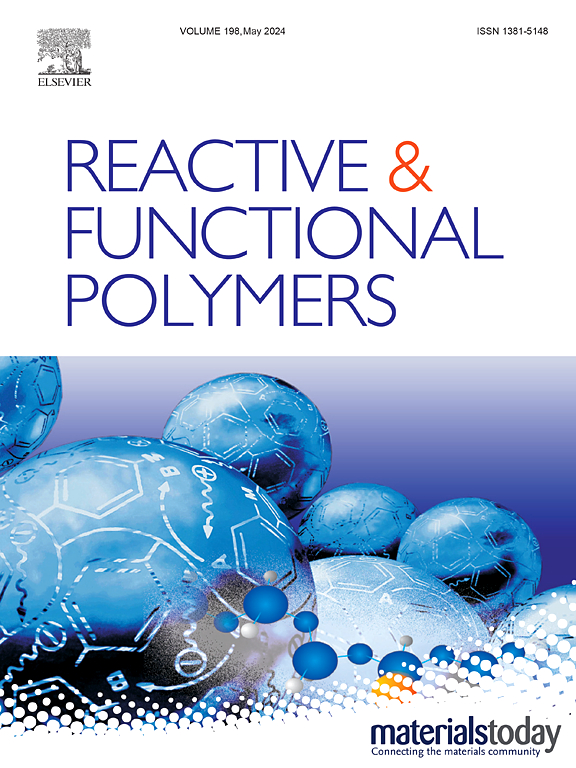双子季铵盐无催化剂合成抗菌聚琥珀酸乙酯
IF 5.1
3区 工程技术
Q1 CHEMISTRY, APPLIED
引用次数: 0
摘要
聚酯具有优异的机械性能、化学稳定性和成本效益,广泛应用于纺织、包装和生物医学材料。然而,合成天然抗菌聚酯仍然具有挑战性。传统的方法往往依赖于金属催化剂,有细胞毒性金属残留物的风险,而传统的聚酯缺乏固有的抗菌活性,需要添加剂。无机抗菌剂可能引起毒性问题,有机抗菌剂在高温加工过程中经常降解。为了解决这些限制,本研究开发了热稳定,可聚合的双gemini季铵(GQA)盐作为抗菌单体。采用无催化剂熔融缩聚的方法,合成了一种抗菌基团共价连接在聚合物主链上的聚琥珀酸乙烯酯(PES)。所得材料保留了与纯PES相当的热学和机械性能。值得注意的是,仅加入0.05 mol%的GQA单体,对金黄色葡萄球菌和大肠杆菌的抗菌效果就接近完全(99.9%)。这种无金属、可扩展的方法可以生产适用于食品包装和生物医学设备等关键应用的高安全性抗菌聚酯。本文章由计算机程序翻译,如有差异,请以英文原文为准。

Catalyst-free synthesis of antibacterial poly(ethylene succinate) with gemini quaternary ammonium salts
Polyesters are widely employed in textiles, packaging, and biomedical materials owing to their excellent mechanical properties, chemical stability, and cost-effectiveness. However, synthesizing inherently antibacterial polyesters remains challenging. Traditional methods often rely on metal catalysts, risking cytotoxic metal residues, while conventional polyesters lack intrinsic antibacterial activity and require additives. Inorganic antibacterial agents may pose toxicity concerns, and organic agents frequently degrade during high-temperature processing. To address these limitations, this study developed thermally stable, polymerizable gemini quaternary ammonium (GQA) salts as antibacterial comonomers. Using catalyst-free melt polycondensation, we synthesized an antibacterial poly(ethylene succinate) (PES) with antibacterial groups covalently bonded to the polymer backbone. The resulting material retained thermal and mechanical properties comparable to pure PES. Notably, incorporating just 0.05 mol% of the GQA comonomer achieved near-complete (>99.9 %) antibacterial efficacy against both Staphylococcus aureus and Escherichia coli. This metal-free, scalable approach enables the production of high-safety antibacterial polyesters suitable for critical applications such as food packaging and biomedical devices.
求助全文
通过发布文献求助,成功后即可免费获取论文全文。
去求助
来源期刊

Reactive & Functional Polymers
工程技术-高分子科学
CiteScore
8.90
自引率
5.90%
发文量
259
审稿时长
27 days
期刊介绍:
Reactive & Functional Polymers provides a forum to disseminate original ideas, concepts and developments in the science and technology of polymers with functional groups, which impart specific chemical reactivity or physical, chemical, structural, biological, and pharmacological functionality. The scope covers organic polymers, acting for instance as reagents, catalysts, templates, ion-exchangers, selective sorbents, chelating or antimicrobial agents, drug carriers, sensors, membranes, and hydrogels. This also includes reactive cross-linkable prepolymers and high-performance thermosetting polymers, natural or degradable polymers, conducting polymers, and porous polymers.
Original research articles must contain thorough molecular and material characterization data on synthesis of the above polymers in combination with their applications. Applications include but are not limited to catalysis, water or effluent treatment, separations and recovery, electronics and information storage, energy conversion, encapsulation, or adhesion.
 求助内容:
求助内容: 应助结果提醒方式:
应助结果提醒方式:


